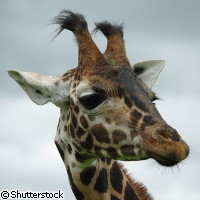Study sheds light on ruminants' tree of life
An international team of researchers has created a 'tree of life' for living and extinct ruminant species. The results, presented in the journal PNAS (Proceedings of the National Academy of Sciences), effectively link the heritage of a diverse group of species. Researchers have long speculated that the higher ruminants called 'Pecorans' speciated (i.e. evolved, forming a new species) in the Mid-Eocene leading to the emergence of five distinct extant families: Antilocapridae, Bovidae, Cervidae, Giraffidae and Moschidae. But the sequence of events that triggered the Pecorans' evolutionary development had, until now, been difficult to decipher. Despite the obvious differences between giraffes and bison, for example, the researchers found that these animals share a common heritage. The team, led by the University of Missouri in the US, showed that a genome-wide single nucleotide polymorphism (SNP) genotyping platform designed for one species can be used to genotype ancient DNA (deoxyribonucleic acid) from an extinct species, as well as DNA from species that diverged up to 29 million years ago. The approach used in this study could potentially transform studies of evolution and domestication through quick and inexpensive generation of data on the evolutionary relationships among species. 'We studied 678 different animals representing 61 different species, and using the new Illumina cow 'SNP chip', we were able to generate very high-quality genotypes in species for which the chip was not designed,' explained Jerry Taylor, a Professor of Genetics and Animal Sciences at the University of Missouri, and lead author of the study. According to the team, the SNP chips enable researchers to assess a huge number of specific positions throughout an animal's genome at the same time. These examinations can help the researchers detect the DNA bases that exist at these sites. 'We were very surprised to find that the chip produced high-quality data in species that were very diverged from cows,' Professor Taylor pointed out. 'In less than a week, we were able to produce five times as much information as has previously been used to construct a 'tree of life' for the ruminants.' The researchers from Australia, Canada, Finland, Kenya, South Korea, the UK and the US also showed how high-throughput genotyping of ancient samples can be performed. They genotyped replicate samples from a fossil bison bone and showed that Bison priscus (the steppe bison) and modern bison were sister species. 'Our results strongly suggest that researchers can assess the fidelity of genotypes they produce from ancient samples by examining where the species is placed in a well-resolved tree, and samples producing unreliable genotypes can be identified and removed from further analysis,' Professor Taylor said. 'When we applied this chip to 48 recognised breeds of cattle, we were able to construct a tree based upon the extent of similarity or difference between the DNA of members of different breeds which allowed us to infer the history of cattle domestication and breed formation across the globe,' he added. Migrations out of the Fertile Crescent (the region in the Middle East where the civilisations of the Middle East and the Mediterranean basin began) likely played a central role in the domestication of European cattle, the research showed. Domesticated cattle moved sequentially through Turkey, the Balkans and Italy, then radiated through central Europe and France, and finally into the British Isles. Professor Taylor pointed out that this technology can potentially be used to shed light on the evolution of humans and plants. And researchers could start investigating genome evolution and the evolution of biological function from a phylogenetic (study of evolutionary relatedness among various organisms) perspective, he added. Professor Taylor went on to say that the research may also benefit scientists seeking to identify animal models for human disease. 'We're all interested in reconstructing our ancestry,' he said. 'This is essentially the same thing, except that we're able to zoom out by millions of years and include relatives who are long gone.'



